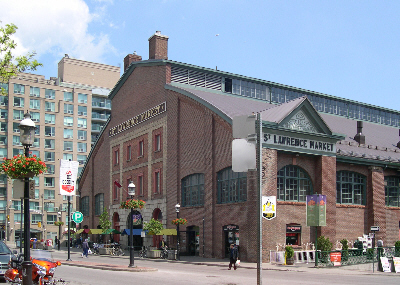For the first eleven years after incorporation in 1834, the council of The City of Toronto used temporary accommodations in the market buildings at King and Jarvis. In 1844, the council sponsored a competition for a proper City Hall. The City’s population had grown from 9,000 in 1834 to over 24,000 and the wealth of the City had also grown, so it could afford a respectable City Hall. This building would house not only municipal offices and the council chambers, but the Police Station Number and the market. The winning design was by Henry Bowyer Lane.
This new City Hall, facing Front Street, was built at a cost of $52,000 on the site of the earlier Farmer’s Storehouse By early 1845, all of the municipal offices had moved into the new building and City Council was holding meetings in the Council Chamber on the second floor. The facade of the City Hall, was Georgian with contrasting red brick and white stone. The three storey centre block was topped by a cupola with a clock. The two wings extending on either side were only two stories high. Police Station Number One was on the main floor of the centre block and the jail cells were in the basement. Flooding of the basement could not be controlled so eventually the cells were relocated elsewhere in the city.

The South Market as it is today
The two story Council Chamber was on the second floor with the public gallery in a balcony above the north end. The second floor also held the offices of the Mayor, the City Clerk and other public officials. On the ground floor of both wings were various shops. On either side of the main entrance there were two archways with passageways from Front Street to the market area at the rear with stalls for fruits, vegetables and poultry.
As the city grew over the nineteenth century, this location became overcrowded and despite renovations in 1851, 1868 & 1872 adding office space and shops and changing the facade, new quarters were needed. A “new” city hall, designed by E.J. Lenox, was built at Bay and Queen. In 1899, civic offices were transferred to what we now call the “Old” City Hall and Toronto’s original City Hall was vacated.
Since 1901, the South St. Lawrence Market has been known primarily for its fruits, vegetables, meat and cheese.
In 1971, the City was advised to demolish the South Market, but a public meeting demonstrated tremendous public opposition. In 1972, a group of Toronto citizens interested in preserving the City’s heritage submitted a proposal recommending
renovation of this historic building and by 1977, the City Property Department was granted funding to restore the original City Hall and the market. Renovations of the market were completed late in 1978. The entire basement was gutted and made available for retail use. The main floor was completely rebuilt. The Market Gallery, on the second floor in the original council chamber, opened in March 1979, as the official exhibition centre for display of the City’s art and archival collections.
Much of this information came from The St. Lawrence Market website www.stlawrencemarket.com
